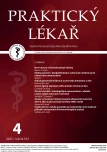Estimation of glomerular filtration rate from serum creatinine in children
Authors:
M. Fořtová 1,2; B. Sopko 1; F. Fencl 3; R. Kizek 1; M. Kohutiar 1; R. Průša 1
Authors‘ workplace:
Ústav lékařské chemie a klinické biochemie 2. LF UK a FN Motol, Praha Přednosta: prof. MUDr. Richard Průša, CSc.
1; Nemocnice Na Homolce, Praha Oddělení klinické biochemie, hematologie a imunologie Primář: doc. MUDr. Miroslav Průcha, Ph. D.
2; Pediatrická klinika 2. LF UK a FN Motol, Praha Přednosta: prof. MUDr. Zdeněk Šumník, Ph. D.
3
Published in:
Prakt. Lék. 2023; 103(4): 174-179
Category:
Of different specialties
Overview
Aim: Comparison of methods for determination of serum creatinine (SCr) and evaluation of the effect of the used method on estimation of glomerular filtration rate (eGFR) in children with kidney disease.
Methods: We assessed SCr in 168 children (102 boys, age 1.7–15.9 years) by both, the Jaffe method and enzymatically. eGFR was estimated by Schwartz formula.
Results: The Jaffe method overestimated SCr at lower levels (< 200 μmol/L) but underestimated it at higher levels (> 250 μmol/L). Up to SCr of 60 μmol/L using Jaffe method, eGFR values were lower with higher SCr in comparison to enzymatic method as expected. However, eGFR values were paradoxically higher in all patients with SCr above 100 μmol/L using Jaffe method. This paradox was especially evident in adolescent boys mainly due to the different F coefficient used for eGFR calculation.
Conclusion: Estimation of GFR depends on the accuracy of the SCr measurement and the F coefficient in the Schwartz formula. These effects can have serious clinical consequences, especially in children with advanced chronic kidney disease stages 4 and 5, when the enzymatic method provides significantly lower eGFR values, which may result in earlier initiation of dialysis treatment.
Keywords:
Creatinine – Jaffe method – enzymatic method – Schwartz formula
Sources
- Kidney Disease: Improving Global Outcomes (KDIGO) CKD Work Group. KDIGO 2012 Clinical practice guideline for the evaluation and management of chronic kidney disease. Kidney Int Suppl. 2013; 3(1): 1–163.
- Pottel H, Dubourg L, Goffin K, Delanaye P. Alternatives for the bedside Schwartz equation to estimate glomerular filtration rate in children. Adv Chronic Kidney Dis. 2018; 25(1): 57–66.
- Schwartz GJ, Muñoz A, Schneider MF, et al. New equations to estimate GFRR in children with CKD. J Am Soc Nephrol. 2009; 20(3): 629–637.
- Srisawasdi P, Chaichanajarernkul U, Teerakanjana N, et al. Exogenous interferences with Jaffe creatinine assays: addition of sodium dodecyl sulfate to reagent eliminates bilirubin and total protein interference with Jaffe methods. J Clin Lab Anal. 2010; 24(3): 123–133.
- Jaffe M. Über den Niederschlag, welchen Pikrinsäure in normalen Harn erzeugt und über eine neue Reaction des Kreatinins. Z Physiol Chem. 1886; 10(5): 391–400.
- Hoste L, Deiteren K, Pottel H, et al. Routine serum creatinine measurements: how well do we perform? BMC Nephrol. 2015; 16: 21.
- Lindbäck B, Bergman A. A new commercial method for the enzymatic determination of creatinine in serum and urine evaluated: comparison with a kinetic Jaffé method and isotope dilution-mass spectrometry. Clin Chem. 1989; 35(5): 835–837.
- Schmidt RL, Straseski JA, Raphael KL, et al. A risk assessment of the Jaffe vs enzymatic method for creatinine measurement in an outpatient population. PLoS One. 2015; 10: e0143205.
- Lee SC, Lim LM, Chang EE, et al. Effect of differences in serum creatinine estimation methodologies on estimated glomerular filtration rate. Singapore Med J. 2019; 60(9): 468–473.
- Lamb EJ, Wood J, Stowe HJ, et al. Susceptibility of glomerular filtration rate estimations to variations in creatinine methodology: a study in older patients. Ann Clin Biochem. 2005; 42(1): 11–18.
- Schwartz GJ, Brion LP, Spitzer A. The use of plasma creatinine concentration for estimating glomerular filtration rate in infants, children, and adolescents. Pediatr Clin North Am. 1987; 34(3): 571–590.
- Fossati P, Prencipe L, Berti G. Enzymic creatinine assay: a new colorimetric method based on hydrogen peroxide measurement. Clin Chem. 1983; 29(8): 1494–1496.
- Manuilova E, Schuetzenmeister A, Model F. mcr: Method Comparison Regression. R package version 1.2.1. 2014 (online). Dostupné z: https://CRAN.R-project.org/package=mcr [cit. 202309-08].
- R Core Team. R: A language and environment for statistical computing. R Foundation for Statistical Computing, Vienna, Austria 2020 (online). Dostupné z: https://www.R-project.org/ [cit. 2023-09-08].
- Nigam PK, Chandra A. Positive and negative false estimates of serum creatinine. Interv Cardiol. 2017; 9(4): 163–167.
- Ducharme MP, Smythe M, Strohs G. Drug-induced alterations in serum creatinine concentrations. Ann Pharmacother. 1993; 27(5): 622–633.
- Klee GG, Schryver PG, Saenger AK, Larson TS. Effects of analytic variations in creatinine measurements on the classification of renal disease using estimated glomerular filtration rate (eGFRR). Clin Chem Lab Med. 2007; 45(6): 737–741.
- Uemura O, Nagai T, Ishikura K, et al. Reference glomerular filtration rate levels in Japanese children: using the creatinine and cystatin C based estimated glomerular filtration rate. Clin Exp Nephrol. 2015; 19(4): 683–687.
- Uemura O, Nagai T, Ishikura K, et al. Creatinine-based equation to estimate the glomerular filtration rate in Japanese children and adolescents with chronic kidney disease. Clin Exp Nephrol. 2014; 18(4): 626–633.
- Zima T, Teplan V, Tesař V, a kol. Doporučení České nefrologické společnosti a České společnosti klinické biochemie ČLS JEP k vyšetřování glomerulární filtrace. Aktual Nefrol. 2009; 15: 129–139.
- Seeman T, Janda J, a kol. Dětská nefrologie. 2. přepracované a doplněné vydání. Praha: Grada Publishing 2021.
Labels
General practitioner for children and adolescents General practitioner for adultsArticle was published in
General Practitioner

2023 Issue 4
Most read in this issue
- New horizons in the drug treatment of obesity
- Estimation of glomerular filtration rate from serum creatinine in children
- Armeo Spring improves quality of movement and quality of life after stroke
- Food components with presumed anticancer effects
